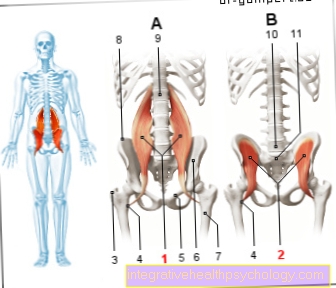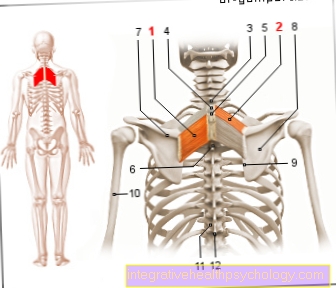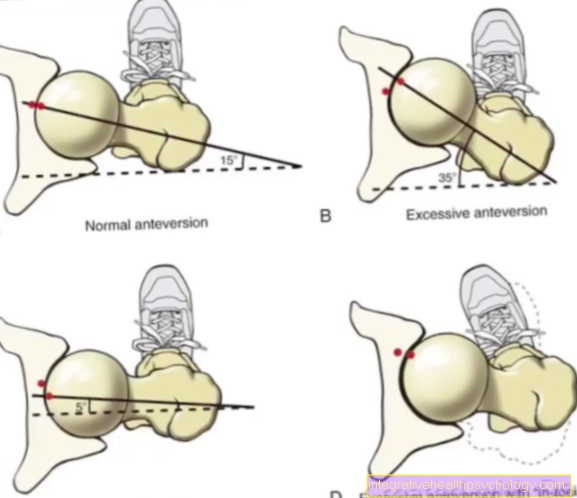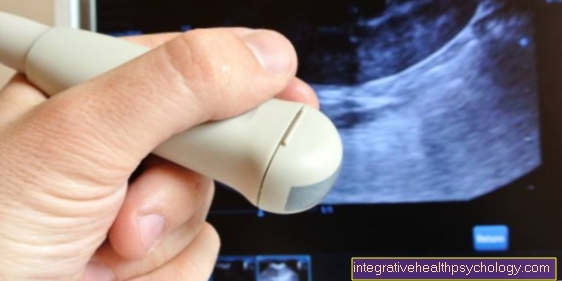Larynx
Synonyms
Adam's apple, glottis, epiglottis, laryngitis, larynx cancer, croup, pseudocroup
Medical: larynx
English: laryngeal
General
The larynx connects the throat (pharynx) with the windpipe (trachea). It is mainly used for breathing and voice training.
It is also involved in the swallowing process and acts as a valve to prevent food and drinks from penetrating the deeper airways.
In men, the larynx emerges as an “Adam's apple” after puberty and provides a deeper voice. A cough reflex is triggered when a foreign body enters the larynx. The larynx supports the formation of a strong flow of air so that the foreign body can be transported out.

Figure larynx
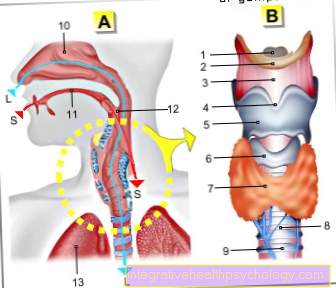
- Epiglottis cartilage -
Cartilago epiglottica - Hyoid bone - Os hyoideum
- Thyroid cartilage-hyoid bone ligament -
Thyrohyoid ligament - Upper thyroid cartilage incision
Incisura thyroidea superior - Thyroid cartilage -
Cartilago thyroidea - Ring Cartilage Brace -
Arcus cartilaginis
cricoideae - Thyroid -
Glandula thyroidea - Ring band -
Ligament annular - Tracheal cartilage -
Cartilago trachealis - Nasal cavity - Cavitas nasi
- Oral cavity - Cavitas oris
- Throat - Pharynx
- Lungs - Pulmo
Airway L - L (blue)
Feed route S - S (red)
You can find an overview of all Dr-Gumpert images at: medical illustrations
Anatomy and function
The larynx consists of different cartilages, which are more and more remodeled into bones in old age. It consists of the following cartilage parts:
- Thyroid cartilage (Cartilago thyroidea)
- Cricoid cartilage (Cartilago cricoidea)
- Cartilage (Cartilago arytaenoidea, arytenoid cartilage)
- Epiglottis (epiglottis)
For clinical and functional reasons, the larynx is divided into three tiers:
- Supraglottic space (Vestibular laryngitis)
- Glottic space (Glottis, rima glottidis)
- Subglottic space
The cartilages are connected to one another by various ligaments and muscles and are therefore mobile. From a functional point of view, a subdivision into different muscle groups is made:
- Vocal cord tensioner vocal cord tensors): M. cricothyroideus, M. vocalis
- Vocal fold opener opener of the glottis): M. cricoarytaenoideus posterior
- Glottis closers closing muscles of the glottis): M. cricoarytaenoideus lateralis and M. arytaenoideus transversus
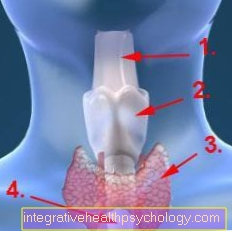
Anatomy of the neck / larynx
- throat
- Thyroid cartilage of the larynx
- thyroid
- Windpipe (trachea)
tasks
When inhaling, the air flows through the larynx after leaving the nasopharynx before it enters the windpipe. When you exhale, the air flows in the opposite direction through the larynx. The larynx is the uppermost section of the airwayswhich the chyme cannot reach during the act of swallowing. In addition, the air flowing past is used when exhaling, around the vocal cords (the vocal cords are parts of the vocal folds) to vibrate, creating a modulatable tone. This enables us to speak. Above the larynx sits the epiglottis, which when swallowing the larynx and thus the Closes and protects airways.
The larynx is a complicated organ, which mainly consists of connective tissue, ligaments, muscles and cartilage. The flexible cartilage serves primarily to protect the sensitive airways and vocal cords, but also determines important properties of the voice. The vocal cords are attached to special cartilage. These act like adjusting screws and above all enable a change in pitch.
Function when breathing
When breathing, the larynx is the topmost Airway section reserved for air. When passing through the larynx, the air you breathe must always be Vocal folds happen. This gap is therefore widened during normal breathing.
With various diseases like that Laryngitis can swell the vocal folds and make air passage difficult. This turns out to be hoarseness noticeable. The feeling of having a lump in the throat can also be caused by a swelling of the vocal folds or a general narrowing of the larynx.
Function when swallowing
During the act of swallowing, the airways must be protected from the chyme. Here the Larynx pulled forward and upward by the neck muscles. This is also clearly visible from the outside as a movement of the thyroid cartilage. As a result, the epiglottis folds over the larynx and closes it, which further prevents the penetration of chyme into the airways.
If this does not succeed, it will be swallowed. Swallowed food gets into the airways and can block them, causing a strong urge to cough. Usually this is enough to clear the airways. If this is not the case, a strong tap on the back and, in extreme cases, the secret maneuver may be necessary.
Function when speaking
The larynx contains the two vocal cords that are part of the vocal folds. They serve the people of Voice generation. When speaking, the vocal folds are almost closed and tense. By flowing air they become set in vibration similar to a guitar string. This creates a sound. Its height can be varied by the tension of the vocal folds.
In addition, the sound in the mouth, nose and throat area is further modulated, creating the different vowels. Consonants, on the other hand, are often generated without involving the larynx. These include, for example, sibilants like S and Z or striking the tongue against the roof of the mouth like D, T and G.
Pain in the larynx
If the Larynx hurts, there can be very different causes behind it. A harmless cold can sometimes cause pain in the larynx. The is also mostly harmless Laryngitis (laryngitis), by Viruses, bacteria or external influences such as Smoke can be triggered. This usually heals without complications.
A more dangerous disease is that Inflammation of the epiglottis (Epiglottitis). She goes with strong Pain when swallowing and high fever hand in hand. In the worst case, epiglottitis can lead to death from suffocation and must therefore be treated by a doctor.
A Throat cancer can also lead to pain in the later stages if the tumor affects nerves by spreading. Accompanying symptoms are common more unwanted Weight loss, profuse night sweats and swollen but painless lymph nodes. If the pain persists, it is advisable to consult a doctor.
Diseases of the larynx
Laryngitis

Under one Laryngitis, which in specialist circles also as laryngitis is referred to, one understands a Inflammation of the lining of the larynx. There are many reasons for this. In most cases, the laryngitis is one Viral infection based on either in Noses- and Pharynx originates and then descends into the Larynx spreads, or the focus of infection is in the lung and then travels up into the larynx area. Are rarer bacteria responsible for a laryngitis.
Further causes can have damaging influences such as Tobacco smoke, fumes or an excessive consumption of alcohol be.
The doctor differentiates between larynx infections acute Form, triggered by Viruses or bacteria, from one chronic Inflammation caused by Voice overload, often observed in singers, or external exposure Pollutants is triggered. Laryngitis can affect the entire lining of the larynx as well as only part of it, for example the vocal folds. With regard to the symptoms, patients initially reported of hoarseness and to cough. Frequent throat clearing can also be noticeable. Patients also rarely complain about it Shortness of breath. The reason for this is usually one Swelling of the vocal folds, those who breathing hindered by greater resistance. Since swelling in the larynx can be life-threatening, an emergency doctor should be alerted in this case for further clarification and, if necessary, hospitalization should be carried out.
The Diagnosis a laryngitis includes next to one anamnese a thorough examination of the throat, pharynx and larynx and, if necessary, a Laryngoscopy, so one Reflection of the larynx. The doctor can do this with a special device, more precisely with a small mirror attached to a rod, the so-called Laryngoscopelook directly into the larynx and vocal cords.
In the therapy of acute laryngitis Inhalations and expectorant and anti-inflammatory drugs but also Steam baths for use. In addition, the voice should be spared. For bacterial infections, a antibiotic used. As a rule, acute laryngitis heals completely. However, it can lead to complications like shortness of breath come who then require further therapy in the hospital. Since chronic laryngitis can be triggered by many different stimuli, the doctor must first determine the cause together with the patient. This is followed by a therapy that is individually tailored to the patient's case. This can Language training with speech therapists or avoiding harmful substances, for example Cigarette smoke.
Larynx swollen

Some important human organs are found in the neck area, including the thyroid, the windpipe, the esophagus and the Larynx. In the case of swelling in the neck area, a precise distinction must therefore be made between what is causing the swelling and which organs are affected. There are different reasons for swelling of the larynx as well as pain. Basically, a doctor should be consulted with a swelling of the larynx, because it is due to the proximity to windpipe too massive Breathing problems can come to the point of death.
A possible root cause for a swollen larynx can be a Laryngeal edema be. This is a collection of fluid in the area around the larynx that flows through Infections, injuries, allergies or tumors can be triggered. As part of a larynx infection it can lead to a Swelling of the mucous membrane as a result of which breathing becomes difficult. The patient reports about shortness of breath and should be looked after by a doctor.
A swollen larynx can also indicate a Epiglottitis (Epiglottitis), which needs urgent treatment as there is a risk of suffocation.
Throat cancer

The throat cancer or also Laryngeal cancer is the most common malicious (malignant) Tumor of the head and neck area. It is a squamous cell carcinoma, which means that the tumor originates from the superficial layer of cells in the larynx called the squamous cell. Men are generally more affected than women.
The causes of cancer of the larynx have not yet been conclusively clarified at this point in time. However, there appears to be a link between smoking and alcohol consumption. Viruses can also trigger a carcinoma.
The symptoms of laryngeal cancer are initially very similar to those of laryngitis. The focus is on changes in the voice, hoarseness and a foreign body sensation in the throat. If the hoarseness lasts longer than about two weeks, it is advisable to consult a doctor! If the cancer of the larynx continues and spreads, the symptoms will spread. Then there is often severe pain when swallowing and bloody sputum. A painless swelling of the lymph nodes in the neck area can also be an indication of a malignant disease of the larynx. Also watch out for excessive, unwanted weight loss and heavy night sweats. If the tumor presses on nerves, it can lead to sensory disturbances and paralysis of the muscles involved. Metastases are rare. The therapy depends on the location, size and extent of the tumor. Radiation therapy, chemotherapy and surgical procedures are used.
You may also be interested in this article: Vocal Cord Cancer - What You Should Know About It




